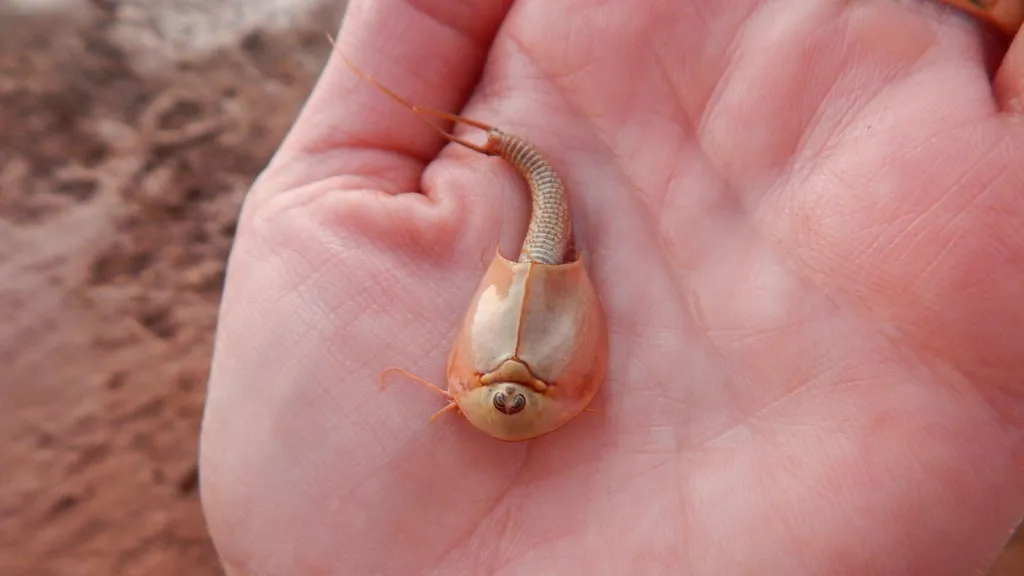You may have heard of Triops before but under a different name. With eggs that can stay dormant for decades and an ability to survive in harsh conditions, they are often sold in kits designed for children, who are encouraged to put the eggs in water and watch the creatures grow.
Often branded as "prehistoric sea creatures," the novelty aquarium pets have three eyes and can reach up to 1 cm when fully grown. They kind of look like tadpoles, but with an extra-terrestrial twist.
 *One of the Triops that emerged in the July storm. (L. Carter/NPS) via LiveScience
*One of the Triops that emerged in the July storm. (L. Carter/NPS) via LiveScience
Back in July, a monsoon hit Flagstaff, Arizona, an area that typically receives around 230 mm of rain a year. But over a period of about 10 days, 127 mm fell, and that was enough to hydrate dormant Triops eggs.
Within a week the hatchlings had matured, and they were visible in a temporary pond that formed in the ball court at Wupatki National Monument, LiveScience reports. Triops sightings are rare, and at first, park staff wasn't sure what to make of them.
Triops usually lay their eggs in the desert, where they remain until enough rain accumulates for them to hatch, creating another generation of crustaceans that will go on to lay more eggs.
They typically live up to 90 days, but the temporary lake only lasted for about a month. And it didn't take long for local wildlife to notice the new addition to the pond, with birds swooping in to eat the critters. It's not clear if any Triops were able to lay eggs before the water evaporated.
Triops can be found in Africa, Australia, Asia, South America, Europe, and North America, typically inhabiting temporary pools. They're often branded as "prehistoric" because their ancestors evolved between 419 and 359 million years ago - long before the dinosaurs made an appearance some 252 million years ago.
While Triops' appearance hasn't changed much in all that time, they have evolved, making the moniker 'prehistoric' somewhat inaccurate.
Triops can help curb the spread of the West Nile virus because they consume mosquito larvae that spread the disease. In Japan, Triops can sometimes be found in rice paddies, eating away at the weeds.
Thumbnail graphic created by Cheryl Santa Maria. Image courtesy: Getty.
https://news.google.com/__i/rss/rd/articles/CBMidmh0dHBzOi8vd3d3LnRoZXdlYXRoZXJuZXR3b3JrLmNvbS9jYS9uZXdzL2FydGljbGUvYXJpem9uYS1tb25zb29uLWNhdXNlcy1kb3JtYW50LWVnZ3Mtb2YtdGhyZWUtZXllZC1wcmVoaXN0b3JpYy1zaHJpbXDSAXpodHRwczovL3d3dy50aGV3ZWF0aGVybmV0d29yay5jb20vY2EvYW1wL25ld3MvYXJ0aWNsZS9hcml6b25hLW1vbnNvb24tY2F1c2VzLWRvcm1hbnQtZWdncy1vZi10aHJlZS1leWVkLXByZWhpc3RvcmljLXNocmltcA?oc=5
2021-10-05 20:03:00Z
CBMidmh0dHBzOi8vd3d3LnRoZXdlYXRoZXJuZXR3b3JrLmNvbS9jYS9uZXdzL2FydGljbGUvYXJpem9uYS1tb25zb29uLWNhdXNlcy1kb3JtYW50LWVnZ3Mtb2YtdGhyZWUtZXllZC1wcmVoaXN0b3JpYy1zaHJpbXDSAXpodHRwczovL3d3dy50aGV3ZWF0aGVybmV0d29yay5jb20vY2EvYW1wL25ld3MvYXJ0aWNsZS9hcml6b25hLW1vbnNvb24tY2F1c2VzLWRvcm1hbnQtZWdncy1vZi10aHJlZS1leWVkLXByZWhpc3RvcmljLXNocmltcA
Tidak ada komentar:
Posting Komentar